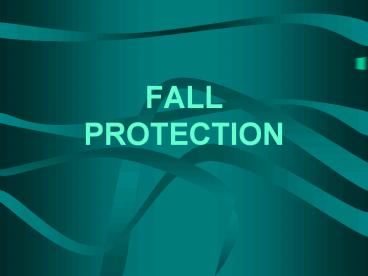FALL PROTECTION - PowerPoint PPT Presentation
Title: FALL PROTECTION
1
FALLPROTECTION
2
Duty To Have Fall Protection
- Protection at or above 6 level
- Walking/working surfaces inspected before work
begins - Employees can only work on surfaces strong enough
to support them
3
Protection Required For
- Unprotected sides and edges
- Leading edges
- ramps, runways and other walkways
- Dangerous equipment
- Overhand bricklaying related work
- Steep Roofs
- Residential construction
- Hoist areas
- Holes
- Formwork reinforcing steel
- Roofing work on low slope roofs
- Pre-cast concrete erection
- Wall openings
- Walking/working surfaces not otherwise addressed
4
Falling Object Protection
- Each exposed employee shall wear a hardhat
- Employer must take steps to prevent employees
from being hit by falling objects
5
Guardrails
- Toprail - 42 /- 3
- Midrails 21 high
- Intermediate members/openings - no greater than
19 - Withstand 200 lbs. Of downward/outward force
- Midrails 150 lbs.
- No Steel, plastic banding
- Wire rope toprail - flagged every 6
- Manila, plastic or synthetic rope rails - inspect
often - All rails 1/4 diameter or greater
6
Safety Net Systems
- As close as practical, no more than 30 below
- Bridges - fall area to net unobstructed
- Sufficient clearance to objects below
- Drop tested or certified
- Outward extension of safety nets
- Vertical Distance Horizontal Distance
- up to 5 8
- gt5 to 10 10
- gt10 13
7
Safety Net Systems(continued)
- No defective nets
- Weekly and after impact inspections
- Removal of objects daily of before next shift
- No greater than 6 openings on any side
- Border ropes 5,000 lbs. Breaking strength
- Connections not more than 6 apart
8
Body Belts
- Body belts not allowed for fall arrest starting
January 1, 1998
9
Dee-rings Snaphooks
- 5,000 lbs. tensile strength
- Proof tested to 3,600 lbs.
- Sized or locking type
- Only locking type after December 31, 1997
10
Lifelines
- On suspension platforms, horizontal lifelines
which may become vertical, require locking
capability in both directions - Horizontal lifelines installed by qualified
person - Safety factor of at least 2
- Lanyards vertical lifelines 5,000 lbs. breaking
strength
11
Personal Fall Arrest
- Body belt arresting force 900 lbs. maximum
- Harness arrest force 1,800 lbs. maximum
- Rigged to fall no more than 6, nor contact lower
level 3.5 deceleration maximum - Provide for prompt rescue
- Inspect prior to each use
12
Positioning Devices
- No more than 2 free fall
- Inspected before each use
- Safety belts are okay for use
13
Warning Lines
- Erected around all sides of roof work area
- No mechanical equipment in use within 6 from
edge - Mechanical equipment in use - 6 parallel to
direction of equipment and 10 on sides
perpendicular to travel direction - Roof access points to be guarded when not to use
- Flag with high visibility material
- No lower than 34 or higher than 39
14
Controlled Access Zones
- Leading edge work
- Overhand bricklaying
- Pre-cast concrete
- Accessible only to those qualified employees
necessary to perform work
15
Safety Monitoring
- Competent person to monitor
- On same level, in visual sight of workers
- Close enough to communicate orally
- No mechanical equipment to be used or stored in
area (roof work only)
- Only employees engaged in roofing work or covered
by fall protection plan in area - Employees must comply with warnings from monitors
- Monitor can have no other duties that interfere
16
Covers
- Vehicular traffic - 2 times maximum axle load of
the largest vehicle - Foot traffic - 2 times the weight of the expected
load - Secured to prevent displacement
- Marked HOLE, COVER or color coded
17
Falling Object Protection
- Screens installed where needed
- Only masonry equipment or materials within 4 of
edge - No material stored within 6 of edge unless
guardrails have been installed and material is
stable self-supported
- Toeboards 4 tall
- Canopies must be strong enough to not collapse
and to prevent penetration of objects - Barricade areas and prohibit entry by employees
18
Fall Protection Plans
- Only available for leading edge work, pre-cast
concrete erection, or residential construction
work - Document reasons for unfeasibility or greater
hazard - Prepared by qualified person for each site
- Maintained up to date at the site
- Can only be changed by a qualified person
- Implemented under the supervision of a competent
person
19
Fall Protection Plans(continued)
- Document alternative measures
- Include a written discussion of other ways to
reduce or eliminate hazards - Identify each location where plan is needed
- Establish controlled access zones
- Implement safety monitoring system at minimum
- Implement changes to correct deficiencies
20
Training Requirements
- Must train employees to fall hazards
- Prepare training certification
- Latest training certification maintained
- Retraining for changes in system or workplace































